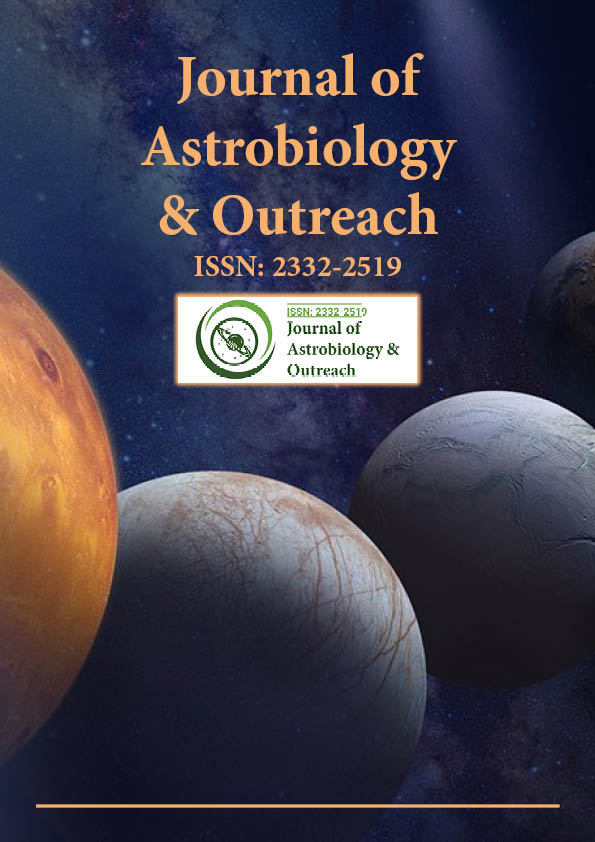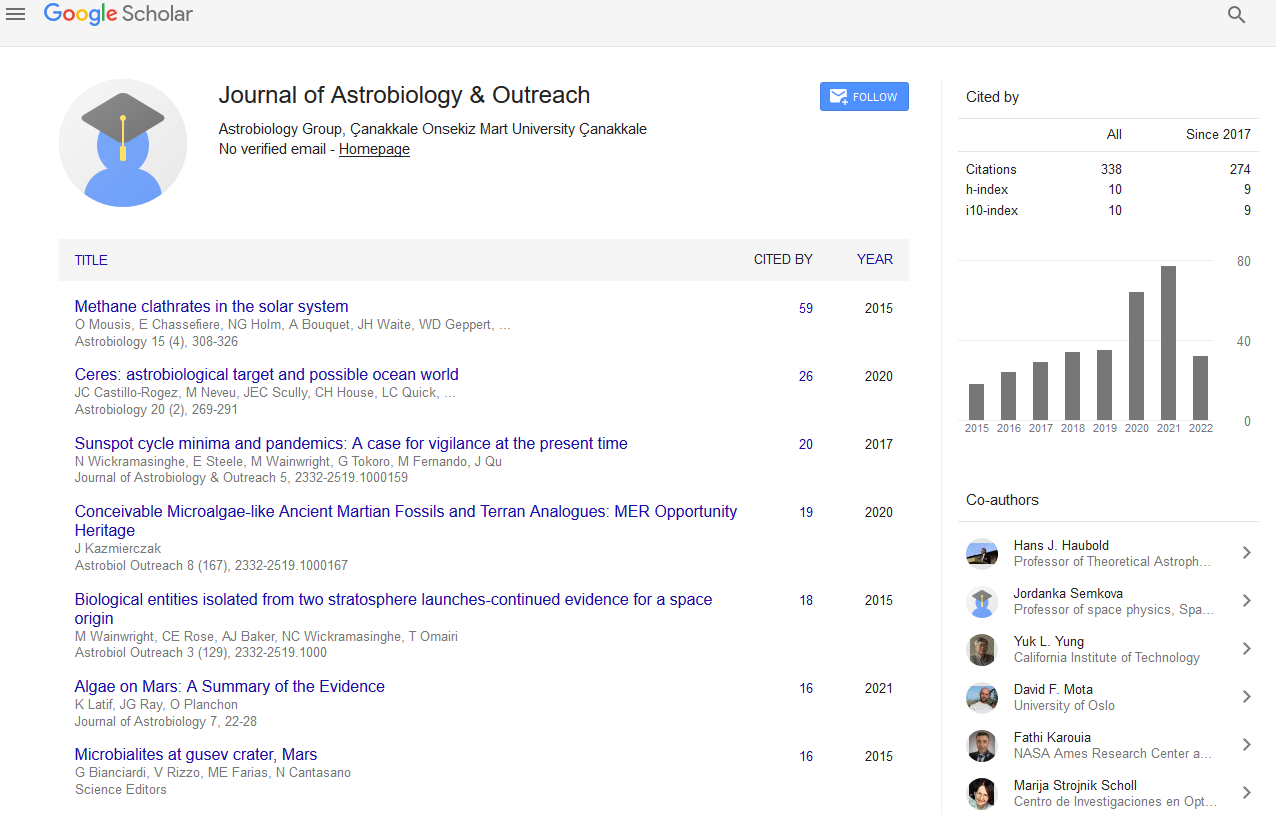Indexed In
- Open J Gate
- Academic Keys
- JournalTOCs
- RefSeek
- Hamdard University
- EBSCO A-Z
- OCLC- WorldCat
- Google Scholar
Useful Links
Share This Page
Journal Flyer

Open Access Journals
- Agri and Aquaculture
- Biochemistry
- Bioinformatics & Systems Biology
- Business & Management
- Chemistry
- Clinical Sciences
- Engineering
- Food & Nutrition
- General Science
- Genetics & Molecular Biology
- Immunology & Microbiology
- Medical Sciences
- Neuroscience & Psychology
- Nursing & Health Care
- Pharmaceutical Sciences
Perspective - (2025) Volume 13, Issue 1
Galactic Processes and the Evolution of Chiral Preference in Life
Rachel Orion*Received: 19-Feb-2025, Manuscript No. JAO-25-28776; Editor assigned: 21-Feb-2025, Pre QC No. JAO-25-28776 (PQ); Reviewed: 07-Mar-2025, QC No. JAO-25-28776; Revised: 14-Mar-2025, Manuscript No. JAO-25-28776 (R); Published: 21-Mar-2025, DOI: 10.35248/2332-2519.25.13.377
Description
The phenomenon of biological homochirality where life exclusively utilizes left-handed (L) amino acids and right-handed (D) sugars remains one of the most enigmatic aspects of molecular biology and the origin of life. While laboratory synthesis typically yields racemic mixtures, terrestrial biochemistry exhibits a striking preference for one chiral form over another. Unraveling the cause of this asymmetry requires an interdisciplinary approach that spans astrophysics, astrochemistry and molecular biology. One compelling hypothesis posits that ultraviolet irradiation, specifically Lyman-α (121.6 nm) photons, during the early formation of the Milky Way could have played a decisive role in establishing a chiral bias in amino acids.
Lyman-α radiation is a dominant component of ultraviolet output from early hot stars and protostars. In the dense molecular clouds where prebiotic molecules are formed on icy grain surfaces, this radiation could have been an important external energy source. When circularly polarized Lyman-α light interacts with chiral organic molecules, it may induce asymmetric photolysis, selectively destroying one enantiomer more efficiently than the other. Over long timescales, even a minute asymmetry in destruction rates could translate into an observable enantiomeric excess a foundational seed for homochirality.
Recent experimental simulations and theoretical models have begun to explore this possibility in greater detail. Laboratory experiments using circularly polarized ultraviolet light on racemic amino acid mixtures frozen in astrophysically relevant ices have shown small but reproducible enantiomeric excesses in the surviving molecules. Notably, these excesses tend to favor L-amino acids when exposed to left-handed circularly polarized Lyman-α light, consistent with the handedness observed in biological systems. These findings lend credence to the idea that photoselective degradation driven by astrophysical radiation could be a primary driver in the origin of chiral asymmetry.
The polarization of Lyman-α radiation itself is believed to originate from scattering processes in regions of intense magnetic fields around massive stars or through alignment with interstellar magnetic fields in star-forming regions. The directionality and handedness of this circular polarization could vary spatially, but regions exhibiting consistent polarization might create molecular clouds with similarly biased chiral signatures. If such a region seeded the molecular inventory of the early solar system, it could explain the uniform homochirality observed in meteoritic amino acids and terrestrial biology.
Meteoritic evidence further supports this hypothesis. Amino acids extracted from carbonaceous chondrites, such as the Murchison meteorite, exhibit small but non-zero enantiomeric excesses that align with the L-form. These chondrites are thought to have originated from parent bodies that formed early in the solar system’s history, possibly inheriting their molecular precursors from interstellar environments influenced by polarized radiation. The consistency of the L-excess in extraterrestrial materials strengthens the argument for an astrophysical origin of homochirality.
Moreover, the early Milky Way was a more hostile and dynamic environment than it is today. The rate of massive star formation and supernovae was higher, leading to increased fluxes of UV and cosmic radiation. This elevated energy environment could have enhanced the rates of chiral-selective processes, embedding a fundamental asymmetry into prebiotic chemistry at a galactic scale. It suggests that homochirality might not be a local accident, but rather a widespread outcome of universal physical processes acting on molecular systems.
However, the hypothesis is not without challenges. The efficiency of asymmetric photolysis is generally low and it is debated whether the small enantiomeric excesses observed in laboratory simulations are sufficient to explain the nearly complete homochirality of biological systems. Secondary amplification mechanisms, such as autocatalysis or crystallization with selective solubility, may be required to translate a modest initial bias into biological exclusivity. Additionally, the spatial and temporal stability of polarized Lyman-α field in star-forming regions remains difficult to quantify observationally.
In conclusion, the origin of homochirality in amino acids may lie in the subtle yet persistent influence of Lyman-α irradiation in the early Milky Way. As observational capabilities and astrochemical models continue to improve, the ability to detect and measure chiral molecules in interstellar environments or on cometary and asteroidal bodies may provide the definitive evidence needed to validate this theory. If confirmed, it would mark an intense connection between the formation of stars, the physics of light and the biochemistry of life linking our molecular origins to the earliest epochs of galactic history.
Citation: Orion R (2025). Galactic Processes and the Evolution of Chiral Preference in Life. J Astrobiol Outreach. 13:377.
Copyright: © 2025 Orion R. This is an open-access article distributed under the terms of the Creative Commons Attribution License, which permits unrestricted use, distribution, and reproduction in any medium, provided the original author and source are credited.

